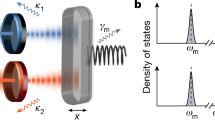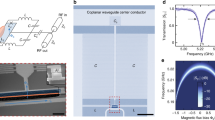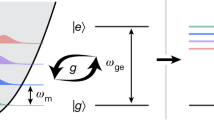Abstract
Monitoring a mechanical object’s motion, even with the gentle touch of light, fundamentally alters its dynamics. The experimental manifestation of this basic principle of quantum mechanics, its link to the quantum nature of light and the extension of quantum measurement to the macroscopic realm have all received extensive attention over the past half-century1,2. The use of squeezed light, with quantum fluctuations below that of the vacuum field, was proposed nearly three decades ago3 as a means of reducing the optical read-out noise in precision force measurements. Conversely, it has also been proposed that a continuous measurement of a mirror’s position with light may itself give rise to squeezed light4,5. Such squeezed-light generation has recently been demonstrated in a system of ultracold gas-phase atoms6 whose centre-of-mass motion is analogous to the motion of a mirror. Here we describe the continuous position measurement of a solid-state, optomechanical system fabricated from a silicon microchip and comprising a micromechanical resonator coupled to a nanophotonic cavity. Laser light sent into the cavity is used to measure the fluctuations in the position of the mechanical resonator at a measurement rate comparable to its resonance frequency and greater than its thermal decoherence rate. Despite the mechanical resonator’s highly excited thermal state (104 phonons), we observe, through homodyne detection, squeezing of the reflected light’s fluctuation spectrum at a level 4.5 ± 0.2 per cent below that of vacuum noise over a bandwidth of a few megahertz around the mechanical resonance frequency of 28 megahertz. With further device improvements, on-chip squeezing at significant levels should be possible, making such integrated microscale devices well suited for precision metrology applications.
This is a preview of subscription content, access via your institution
Access options
Subscribe to this journal
Receive 51 print issues and online access
$199.00 per year
only $3.90 per issue
Buy this article
- Purchase on Springer Link
- Instant access to full article PDF
Prices may be subject to local taxes which are calculated during checkout




Similar content being viewed by others
References
Braginsky, V. & Khalili, F. Quantum Measurements (Cambridge Univ. Press, 1995)
Clerk, A. A., Devoret, M. H., Girvin, S. M., Marquardt, F. & Schoelkopf, R. J. Introduction to quantum noise, measurement, and amplification. Rev. Mod. Phys. 82, 1155–1208 (2010)
Caves, C. M. Quantum-mechanical noise in an interferometer. Phys. Rev. D 23, 1693–1708 (1981)
Fabre, C. et al. Quantum-noise reduction using a cavity with a movable mirror. Phys. Rev. A 49, 1337–1343 (1994)
Mancini, S. & Tombesi, P. Quantum noise reduction by radiation pressure. Phys. Rev. A 49, 4055–4065 (1994)
Brooks, D. W. C. et al. Non-classical light generated by quantum-noise-driven cavity optomechanics. Nature 488, 476–480 (2012)
Yuen, H. P. Two-photon coherent states of the radiation field. Phys. Rev. A 13, 2226–2243 (1976)
Hollenhorst, J. N. Quantum limits on resonant-mass gravitational-radiation detectors. Phys. Rev. D 19, 1669–1679 (1979)
Walls, D. F. Squeezed states of light. Nature 306, 141–146 (1983)
Slusher, R. E., Hollberg, L. W., Yurke, B., Mertz, J. C. & Valley, J. F. Observation of squeezed states generated by four-wave mixing in an optical cavity. Phys. Rev. Lett. 55, 2409–2412 (1985)
Shelby, R. M., Levenson, M. D., Perlmutter, S. H., DeVoe, R. G. & Walls, D. F. Broad-band parametric deamplification of quantum noise in an optical fiber. Phys. Rev. Lett. 57, 691–694 (1986)
Wu, L.-A., Kimble, H. J., Hall, J. L. & Wu, H. Generation of squeezed states by parametric down conversion. Phys. Rev. Lett. 57, 2520–2523 (1986)
Grangier, P., Slusher, R. E., Yurke, B. & LaPorta, A. Squeezed-light-enhanced polarization interferometer. Phys. Rev. Lett. 59, 2153–2156 (1987)
Mehmet, M. et al. Squeezed light at 1550 nm with a quantum noise reduction of 12.3 dB. Opt. Express 19, 25763–25772 (2011)
The LIGO Scientific Collaboration. A gravitational wave observatory operating beyond the quantum shot-noise limit. Nature Phys. 7, 962–965 (2011)
Taylor, M. A. et al. Biological measurement beyond the quantum limit. Nature Photon. 7, 229–233 (2013)
Hoff, U. B. et al. Quantum-enhanced micromechanical displacement sensitivity. Opt. Lett. 38, 1413–1415 (2013)
Caves, C. M. Quantum-mechanical radiation-pressure fluctuations in an interferometer. Phys. Rev. Lett. 45, 75–79 (1980)
Abbott, B. et al. Observation of a kilogram-scale oscillator near its quantum ground state. N. J. Phys. 11, 073032 (2009)
Teufel, J. D. et al. Sideband cooling of micromechanical motion to the quantum ground state. Nature 475, 359–363 (2011)
Gigan, S. et al. Self-cooling of a micromirror by radiation pressure. Nature 444, 67–70 (2006)
Arcizet, O., Cohadon, P.-F., Briant, T., Pinard, M. & Heidmann, A. Radiation-pressure cooling and optomechanical instability of a micromirror. Nature 444, 71–74 (2006)
Corbitt, T., Ottaway, D., Innerhofer, E., Pelc, J. & Mavalvala, N. Measurement of radiation-pressure-induced optomechanical dynamics in a suspended Fabry-Perot cavity. Phys. Rev. A 74, 021802 (2006)
Murch, K. W., Moore, K. L., Gupta, S. & Stamper-Kurn, D. M. Observation of quantum-measurement backaction with an ultracold atomic gas. Nature Phys. 4, 561–564 (2008)
Eichenfield, M., Camacho, R., Chan, J., Vahala, K. J. & Painter, O. A picogram- and nanometre-scale photonic-crystal optomechanical cavity. Nature 459, 550–555 (2009)
Chan, J. et al. Laser cooling of a nanomechanical oscillator into its quantum ground state. Nature 478, 89–92 (2011)
Gardiner, C. W. & Collett, M. J. Input and output in damped quantum systems: quantum stochastic differential equations and the master equation. Phys. Rev. A 31, 3761–3774 (1985)
Purdy, T. P., Peterson, R. W. & Regal, C. A. Observation of radiation pressure shot noise on a macroscopic object. Science 339, 801–804 (2013)
Verhagen, E., Deléglise, S., Weis, S., Schliesser, A. & Kippenberg, T. J. Quantum-coherent coupling of a mechanical oscillator to an optical cavity mode. Nature 482, 63–67 (2012)
Liu, Y. T. & Thorne, K. S. Thermoelastic noise and homogeneous thermal noise in finite sized gravitational-wave test masses. Phys. Rev. D 62, 122002 (2000)
Acknowledgements
We would like to thank K. Hammerer and A. A. Clerk for discussions. This work was supported by the DARPA/MTO ORCHID programme through a grant from the AFOSR; the Institute for Quantum Information and Matter, an NSF Physics Frontiers Center with support of the Gordon and Betty Moore Foundation; the Vienna Science and Technology Fund WWTF; the European Commission, through IP SIQS and iQUOEMS; and the European Research Council. A.H.S.-N. and J.C. gratefully acknowledge support from NSERC. S.G. acknowledges support from the European Commission through a Marie Curie Fellowship.
Author information
Authors and Affiliations
Contributions
A.H.S.-N., S.G. and M.A. designed the experiment. A.H.S.-N., S.G., J.C. and J.T.H. designed and fabricated the device, and performed the measurements. A.H.S.-N., S.G., J.T.H. and O.P. performed the analysis and modelling of the data. All authors were involved in writing and editing the paper.
Corresponding author
Ethics declarations
Competing interests
The authors declare no competing financial interests.
Supplementary information
Supplementary Information
This file contains Supplementary Text and Data 1-6, Supplementary Figures 1-15, Supplementary Table 1 and additional references. (PDF 2030 kb)
Rights and permissions
About this article
Cite this article
Safavi-Naeini, A., Gröblacher, S., Hill, J. et al. Squeezed light from a silicon micromechanical resonator. Nature 500, 185–189 (2013). https://doi.org/10.1038/nature12307
Received:
Accepted:
Published:
Issue Date:
DOI: https://doi.org/10.1038/nature12307
This article is cited by
-
Intracavity-squeezed Cooling in the via Quadratic Optomechanical Coupling with the Hybrid Optomechanical System
International Journal of Theoretical Physics (2024)
-
Study of optical bistability/multistability and transparency in cavity-assisted-hybrid optomechanical system embedded with quantum dot molecules
Optical and Quantum Electronics (2024)
-
Integrated quantum optical phase sensor in thin film lithium niobate
Nature Communications (2023)
-
Temperature-dependent photo-elastic coefficient of silicon at 1550 nm
Scientific Reports (2023)
-
Auxiliary-Cavity-Induced Ultrasensitive and Ultrahigh-Resolution Biomolecule Mass Sensing in a Hybrid Spinning Resonator System
Journal of Russian Laser Research (2023)
Comments
By submitting a comment you agree to abide by our Terms and Community Guidelines. If you find something abusive or that does not comply with our terms or guidelines please flag it as inappropriate.



